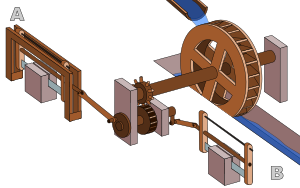Hierapolis sawmill facts for kids
The Hierapolis sawmill was an amazing ancient machine. It was a water-powered sawmill built by the Romans. You could find it in Hierapolis, a city in Asia Minor. Today, this area is part of Turkey.

This sawmill was built around the late 200s AD. It's super important because it's the oldest known machine. It was the first to combine a crank with a connecting rod. This combination creates a special movement called a crank slider mechanism. It's a bit like how a bicycle pedal works!
We know about this sawmill from a stone carving. It's on the sarcophagus (a stone coffin) of a man named Marcus Aurelius Ammianos. He was a local miller, someone who worked with mills.
The carving shows a waterwheel being turned by water. This water came from a special channel called a mill race. The waterwheel then powered the sawmill using a system of gears. These gears moved two frame saws. The saws cut large stone blocks into rectangular shapes. They did this using connecting rods and cranks. The writing on the carving is in Greek. It says that Ammianos was very skilled with wheels.
Other Ancient Sawmills
The Hierapolis sawmill wasn't the only one. Other Roman sawmills also used cranks and connecting rods. These were found in places like Gerasa, Jordan, and Ephesus, Turkey. These sawmills date back to the 500s AD.
There might have been another sawmill in Augusta Raurica, Switzerland. A metal crankshaft from the 100s AD was found there.
Writers from ancient times also mentioned water-powered saws. For example, the poet Ausonius wrote about marble saws in Trier, Germany. This was in the late 300s AD. Around the same time, Saint Gregory of Nyssa from Anatolia also talked about them. This shows that Romans used water power in many different ways across their huge Roman Empire.
The discovery of these ancient sawmills changed what we thought about inventions. It means the crank and connecting rod system was invented a thousand years earlier than previously believed! This is a big deal because these parts are key to many modern machines.
Think about the steam engine, invented in 1712. Many of its basic parts were known in Roman times:
- Hero's aeolipile could create steam power.
- Cylinders and pistons were used in metal pumps.
- Valves that let water flow only one way were in water pumps.
- Gears were used in water mills and clocks.
With the crank and connecting rod, the Romans had all the main pieces. They had the technology to build something like a steam engine!
See also
- List of Roman watermills
- Barbegal aqueduct and mill

